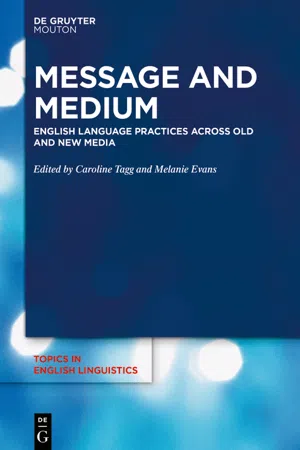
Message and Medium
English Language Practices Across Old and New Media
- 398 pages
- English
- ePUB (mobile friendly)
- Available on iOS & Android
About This Book
Studies of digital communication technologies often focus on the apparently unique set of multimodal resources afforded to users and the development of innovative linguistic strategies for performing mediatised identities and maintaining online social networks.
This edited volume interrogates the novelty of such practices by establishing a transhistorical approach to the study of digital communication. The transhistorical approach explores language practices as lived experiences grounded in historical contexts, and aims to identify those elements of human behaviour that transcend historical boundaries, looking beyond specific developments in communication technologies to understand the enduring motivations and social concerns that drive human communication.
The volume reveals long-term patterns in the indexical functions of seemingly innovative written and multimodal resources and the ideologies that underpin them, and shows that methods are not necessarily contingent on their datasets: historical analytic frameworks can be applied to digital data and newer approaches used to understand historical data. These insights present exciting opportunities for English language researchers, both historical and modern.
Frequently asked questions
Information
Section 1: Rethinking Perspectives
Introduction to rethinking perspectives
References
1 The rise of the Pragmatic Web: Implications for rethinking meaning and interaction
1.1 “This is your digital life”
Table of contents
- Title Page
- Copyright
- Contents
- Acknowledgments
- List of contributors
- Introducing transhistorical approaches to digital language practices
- Section 1: Rethinking Perspectives
- 1 The rise of the Pragmatic Web: Implications for rethinking meaning and interaction
- 2 Interpreting “historicisation” in the digital context: On the interface of diachronic and synchronic pragmatics
- 3 Spelling in context: A transhistorical pragmatic perspective on orthographic practices in English
- 4 Reflections on historicity, technology and the implications for method in (historical) pragmatics
- Section 2: Historicizing Discourses
- Section 3: Media Trajectories
- 10 Unstable content, remediated layout: Urban laws in Scotland through manuscript and print
- 11 Visual pragmatics of an early modern book: Printers’ paratextual choices in the editions of The School of Vertue
- 12 Paratextual presentation of Christopher St German’s Doctor and Student 1528–1886
- 13 Reflections on visuality and textual reception
- Section 4: New to Old
- Index